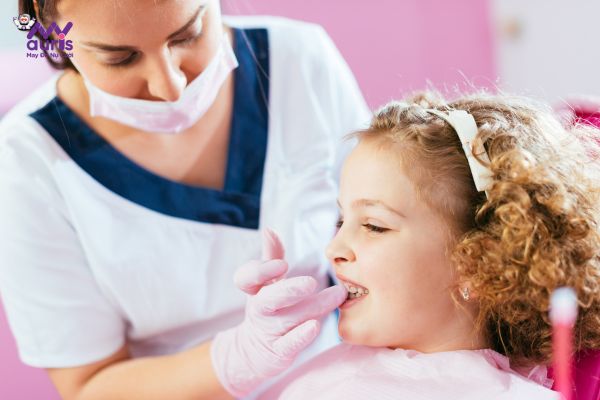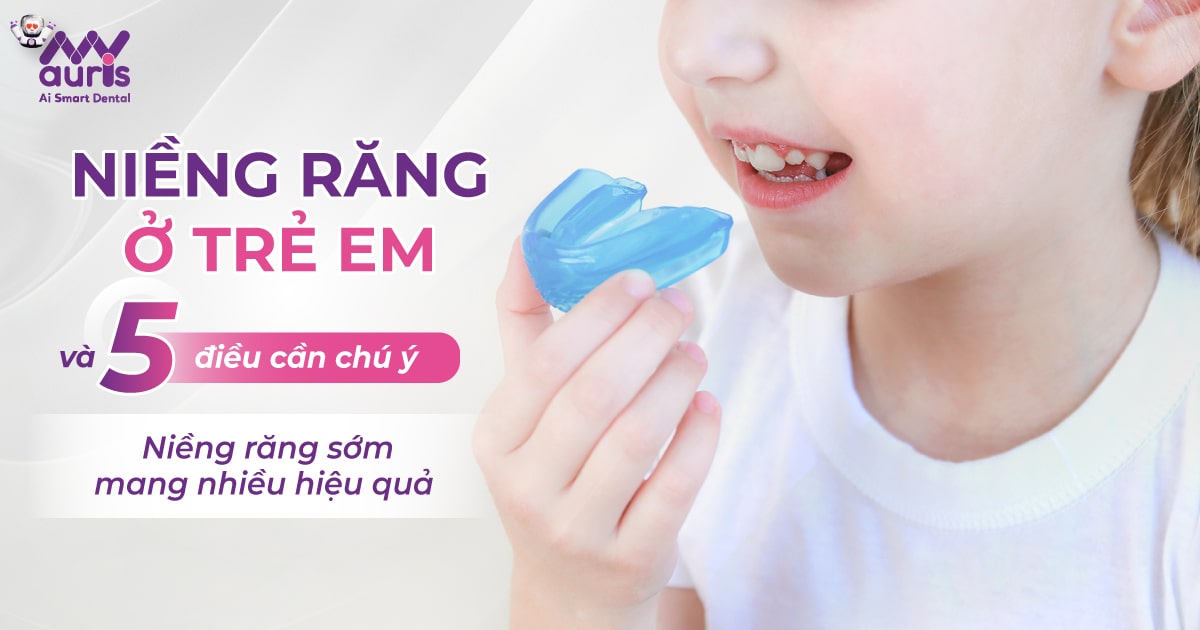Not only adults, children are also interested in orthodontics. Because early braces and orthodontics for children will bring many benefits later, both in terms of aesthetics and oral function. To learn aboutbraces in children, let’s explore the following article with My Auris dentistry.
What is braces in children?
Braces in children is an orthodontic technique that also uses gas tools like braces in adults. They can be fixed appliances such as braces, archwires or removable appliances, which are transparent braces to apply force to straighten teeth into the correct position on the jaw. From there, it helps children be more confident with even, beautiful teeth and standard bite in the future.
Furthermore, when they grow up, their face and teeth are in harmony, helping children to be confident in all situations and have more opportunities in study and work. In addition, orthodontics in children also improves chewing and oral hygiene, helping to better protect oral health.
Instances where children should have braces:
- Spreaded teeth, gaps between teeth, not close together
- Teeth growing haphazardly, crowded together on the jaw
- Protruding teeth, even if the mouth is closed, the jaw is still not closed
- Underbite teeth, making the child’s face unbalanced and concave
- Deep bite, when the child smiles only the upper jaw is visible.
- Cross bite, one or more teeth growing in the wrong position on the jaw.
- Open bite, upper and lower jaws are far apart even at rest.

Advantages of braces in children em >
Early orthodontics for children brings many benefits to children later:
- Corrects misaligned teeth, brings teeth back to physiological bite, helps chewing conveniently, and prevents digestive and stomach diseases.
- Change deviations or unaesthetics, balance the face, jaw, and teeth, helping children increase their beauty and beauty.
- Easy oral hygiene, preventing oral diseases such as tooth decay, gingivitis, pulpitis, mouth ulcers,…
- Helps children pronounce correctly and be confident in communication
- Supports the process of replacing children’s teeth, helping permanent teeth grow in the correct position.
- Limit injuries in cases of overbite or protrusion of teeth.
- If children get braces early, it is highly effective, shortens treatment time and limits pain and discomfort.

Golden time for braces in children
According to orthodontists, the sooner children get braces, the better it will be, especially between the ages of 6-12 years old. This is the ideal age, considered the golden age to perform orthodontics. Because at this stage, the child’s jawbone and tooth replacement are taking place and are not yet complete, so it is easy to straighten and arrange the teeth in the correct position.
At the early stages of 6-7 years old, parents should take their children to see a specialist in orthodontics to assess jaw bone development and monitor the process of replacing baby teeth. If you wait until the age of 12 when the permanent teeth are completely grown before starting adjustment, the jaw bone growth is almost complete, so orthodontic treatment becomes more difficult.
Braces methods in children
In children, there are currently 3 popular orthodontic methods:
Using growth orthodontic appliances
Growth orthodontic appliances are for children from 6-12 years old to intervene to adjust the jawbone. These appliances have the effect of adjusting the jawbone to the correct position and evenly round tooth arch. After using orthodontic appliances, children will have their bite and tooth position adjusted using fixed or removable appliances.
Using fixed orthodontic appliances
This is a popular orthodontic method used in adults. This method is also used for orthodontic treatment of children, possibly childrenMetal braces or ceramic braces. Ceramic or metal braces both have similar operating principles, the only difference is the material that makes the braces. Ceramic braces are more aesthetically pleasing than metal braces. The treatment phase with braces can last from 1-2 years depending on the degree of misalignment and the child’s dental condition.
Using removable orthodontic appliances
Removable appliances are commonly used appliances for children in orthodontics. Accordingly, the doctor will prescribe the type of braces suitable for the child and family conditions. The braces are made of transparent plastic, according to each child’s specifications. When wearing the tray, it will hug the dental arch and exert force to help the teeth move. With easy and flexible disassembly, children will find it easier and more comfortable to live, eat, and clean their teeth.
Normally, removable appliances are often applied to the following cases:
- Children enter the age of 10-11, at the stage of changing their last tooth.
- Children have mild jaw narrowing or teeth misalignment such as spaced, crowded, crooked, protruding, underbite teeth.
- Children are entering the stage of completing the correction of jaw bone misalignment (if any).

Notes on dental care after children get braces teeth
Care after braces is extremely important to protect oral health. However, young children are not aware of this importance, so parents when giving braces to their children need to pay special attention and remind them about how to take care of their teeth:
- Help children psychologically balance: share and encourage children why they have to get braces and take care of their teeth.
- Remind children to wear orthodontic appliances on time if they choose removable braces.
- Nutrition for children after braces is important. Children should eat a variety of foods, but they should be prepared in liquid and crushed foods such as porridge, soup, oatmeal, soft pasta, etc. to reduce pain and comfort children when eating.
- Supplement children with plenty of fruits and vegetables, along with complementary foods that do not affect braces such as milk, yogurt, and syrup.smoothies, fruit juice, cheese,…
- Avoid giving children hard foods, do not let them chew hard candies, hard nuts, chew ice,… or sticky foods such as marshmallows, sticky rice cakes, chewing gum, etc. Also limit giving children foods high in sugar and dark colors such as carbonated soft drinks, tea, caramel,…
- Instruct your child to clean regularly according to your doctor’s instructions such as: using a toothbrush to clean the tooth surface, combined with using an interdental brush, dental floss, and specialized mouthwash to clean the oral cavity.
- Bring your child for regular check-ups on schedule with the doctor to control the process of tooth movement and prevent problems from arising.

Hopefully sharing in the article about braces in children will help people better understand the benefits of this method. From there, consider your child’s condition and go to a reputable dentist to learn about appropriate and effective treatment methods. Please contact My Auris dentistry immediately for detailed advice and answers about braces methods for both children and adults.
Anh Thy





